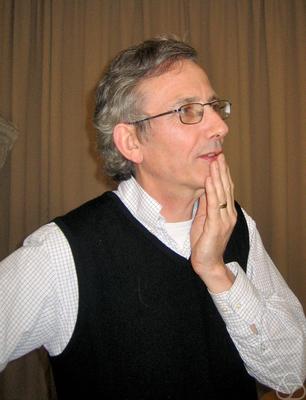
In mathematics, differential topology is the field dealing with the topological properties and smooth properties of smooth manifolds. In this sense differential topology is distinct from the closely related field of differential geometry, which concerns the geometric properties of smooth manifolds, including notions of size, distance, and rigid shape. By comparison differential topology is concerned with coarser properties, such as the number of holes in a manifold, its homotopy type, or the structure of its diffeomorphism group. Because many of these coarser properties may be captured algebraically, differential topology has strong links to algebraic topology.
Sergei Petrovich Novikov was a Soviet and Russian mathematician, noted for work in both algebraic topology and soliton theory. He became the first Soviet mathematician to receive the Fields Medal in 1970.

Sir Simon Kirwan Donaldson is an English mathematician known for his work on the topology of smooth (differentiable) four-dimensional manifolds, Donaldson–Thomas theory, and his contributions to Kähler geometry. He is currently a permanent member of the Simons Center for Geometry and Physics at Stony Brook University in New York, and a Professor in Pure Mathematics at Imperial College London.
In geometric topology, the Property P conjecture is a statement about 3-manifolds obtained by Dehn surgery on a knot in the 3-sphere. A knot in the 3-sphere is said to have Property P if every 3-manifold obtained by performing (non-trivial) Dehn surgery on the knot is not simply-connected. The conjecture states that all knots, except the unknot, have Property P.
In mathematics, Khovanov homology is an oriented link invariant that arises as the cohomology of a cochain complex. It may be regarded as a categorification of the Jones polynomial.
In mathematics, Floer homology is a tool for studying symplectic geometry and low-dimensional topology. Floer homology is a novel invariant that arises as an infinite-dimensional analogue of finite-dimensional Morse homology. Andreas Floer introduced the first version of Floer homology, now called symplectic Floer homology, in his proof of the Arnold conjecture in symplectic geometry. Floer also developed a closely related theory for Lagrangian submanifolds of a symplectic manifold. A third construction, also due to Floer, associates homology groups to closed three-dimensional manifolds using the Yang–Mills functional. These constructions and their descendants play a fundamental role in current investigations into the topology of symplectic and contact manifolds as well as (smooth) three- and four-dimensional manifolds.

Ciprian Manolescu is a Romanian-American mathematician, working in gauge theory, symplectic geometry, and low-dimensional topology. He is currently a professor of mathematics at Stanford University.
Peter Benedict Kronheimer is a British mathematician, known for his work on gauge theory and its applications to 3- and 4-dimensional topology. He is William Caspar Graustein Professor of Mathematics at Harvard University and former chair of the mathematics department.
In mathematics, a smooth algebraic curve in the complex projective plane, of degree , has genus given by the genus–degree formula

Clifford Henry Taubes is the William Petschek Professor of Mathematics at Harvard University and works in gauge field theory, differential geometry, and low-dimensional topology. His brother is the journalist Gary Taubes.
The Oswald Veblen Prize in Geometry is an award granted by the American Mathematical Society for notable research in geometry or topology. It was funded in 1961 in memory of Oswald Veblen and first issued in 1964. The Veblen Prize is now worth US$5000, and is awarded every three years.
John Willard Morgan is an American mathematician known for his contributions to topology and geometry. He is a Professor Emeritus at Columbia University and a member of the Simons Center for Geometry and Physics at Stony Brook University.
In knot theory, the Milnor conjecture says that the slice genus of the torus knot is

Tomasz Mrowka is an American mathematician specializing in differential geometry and gauge theory. He is the Singer Professor of Mathematics and former head of the Department of Mathematics at the Massachusetts Institute of Technology.

Matthias Kreck is a German mathematician who works in the areas of Algebraic Topology and Differential topology. From 1994 to 2002 he was director of the Oberwolfach Research Institute for Mathematics and from October 2006 to September 2011 he was the director of the Hausdorff Center for Mathematics at the University of Bonn, where he is currently a professor.
In mathematics, the Kronheimer–Mrowka basic classes are elements of the second cohomology of a simply connected, smooth 4-manifold of simple type that determine its Donaldson polynomials. They were introduced by Peter B. Kronheimer and Tomasz S. Mrowka.
Alison Beth Miller is an American mathematician who was the first American female gold medalist at the International Mathematical Olympiad. She also holds the distinction of placing in the top 16 of the Putnam Competition four times, the last three of which were recognized by the Elizabeth Lowell Putnam award for outstanding performance by a woman on the contest.
This is a glossary of properties and concepts in symplectic geometry in mathematics. The terms listed here cover the occurrences of symplectic geometry both in topology as well as in algebraic geometry. The glossary also includes notions from Hamiltonian geometry, Poisson geometry and geometric quantization.

Dan Burghelea is a Romanian-American mathematician, academic, and researcher. He is an Emeritus Professor of Mathematics at Ohio State University.







